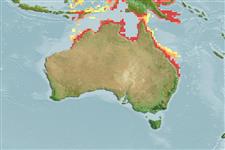Common names from other countries
>
Carangaria/misc (Various families in series Carangaria) >
Polynemidae (Threadfins)
Etymology: Polydactylus: Greek, poly = a lot of + greek, daktylos = finger (Ref. 45335).
More on author: Günther.
Environment: milieu / climate zone / depth range / distribution range
Ecologia
marinhas; Água doce; estuarina demersal; catádromo (Ref. 51243); intervalo de profundidade 0 - 6 m (Ref. 57343). Tropical; 5°S - 28°S, 121°E - 154°E (Ref. 57343)
Indo-West Pacific: southern New Guinea and northern Australia.
Tamanho / Peso / Idade
Maturity: Lm ? range ? - ? cm
Max length : 170 cm FL macho/indeterminado; (Ref. 6390); common length : 48.0 cm FL macho/indeterminado; (Ref. 9685); peso máx. Publicado: 45.0 kg (Ref. 9685); Idade máx. registada: 20 anos (Ref. 6390)
Descrição breve
Morfologia | Morfometria
Body without spots nor stripes. Pectoral fin rays unbranched; 4th pectoral filament long, 40-53% of SL. Second spine of dorsal fin more robust than the rest. Posterior margin of maxilla extending considerably beyond level of posterior margin of adipose eyelid. Lower tip of 7th proximal pterygiophore of 1st dorsal fin directed backward. Lateral squamation on caudal fin unbranched (Ref. 40970).
Found in shallow, turbid waters coastal waters, estuaries, mangrove creeks, and mangrove-lined rivers (Ref. 57343), over sandbanks and mud substrates (Ref. 6390). Usually forms loose schools, although larger fish are more often observed in pairs or singly (Ref. 6390). Feeds on prawns and fish. Protandrous hermaphrodites.
Life cycle and mating behavior
Maturidade | Reprodução | Desova | Ovos | Fecundidade | Larvas
King threadfin between 70 cm and 100 cm FL may be transitional hermaphrodites (they possess mature male and immature female reproductive tissue, and function as males (Ref. 28736)). However, most king threadfin less than 80 cm FL are males and most more than 95 cm FL are females (Ref. 28737). Transitional king threadfin are most often found in the months of June, July, August and September (Ref. 6390).
There is little information on the larvae, although nursery areas are known to be inshore, shallow and of low salinity (Ref. 6390).
Motomura, H., 2004. Threadfins of the world (Family Polynemidae). An annotated and illustrated catalogue of polynemid species known to date. FAO Spec. Cat. Fish. Purp. Rome: FAO. 3:117 p. (Ref. 57343)
Categoria na Lista Vermelha da IUCN (Ref. 130435)
CITES (Ref. 128078)
Not Evaluated
Ameaça para o homem
Harmless
Utilização humana
Pescarias: espécies comerciais; peixe desportivo: sim
Mais informação
ReferênciasAquaculturaPerfil para aquaculturaEstirpesGenéticaElectrophoresesHereditariedadeDoençasProcessamentoMass conversion
ColaboradoresFotografiasStamps, Coins Misc.SonsCiguateraVelocidadeTipo de nataçãoÁrea branquialOutras referênciasCérebrosVisão
Ferramentas
Relatórios especiais
Descarregue XML
Fontes da internet
Estimates based on models
Preferred temperature (Ref.
115969): 24.8 - 28.9, mean 28 (based on 575 cells).
Phylogenetic diversity index (Ref.
82804): PD
50 = 0.5000 [Uniqueness, from 0.5 = low to 2.0 = high].
Bayesian length-weight: a=0.00676 (0.00311 - 0.01469), b=3.10 (2.93 - 3.27), in cm Total Length, based on LWR estimates for this Genus-body shape (Ref.
93245).
Nível Trófico (Ref.
69278): 4.0 ±0.4 se; based on diet studies.
Resiliência (Ref.
120179): Baixo, tempo mínimo de duplicação da população 4,5 - 14 anos (tmax=20).
Fishing Vulnerability (Ref.
59153): High to very high vulnerability (66 of 100).
